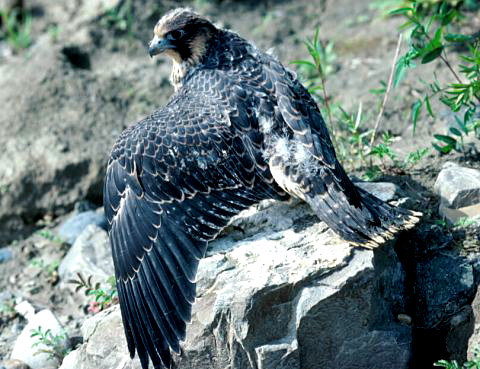

The American Peregrine Falcon can fly at 60 miles per hour and dive at over 200, making it the world's fastest animal. Diving on its avian prey, it snatches them from midair or knocks them from the sky with clenched feet. Traditionally nesting on remote cliffs in the wilds of America, it now also uses the window ledges of skyscrapers, feasting on an abundance of pigeons.
A threat that almost destroyed this magnificent species came during the
late 1940s, when the pesticide DDT was introduced. When ingested, DDT is stored in the
fatty tissue of animals. It increases through each successive level of the food chain,
affecting most strongly the top-level birds of prey. The results—thin shelled or
non-viable eggs—and disaster! DDT was banned in 1972, and the peregrines have
been slowly recovering. In 1999, Peregrines were removed from the endangered species
list, thanks to recovery efforts aided by concerned scientists and falconers who have
revered the peregrine for its speed and aerial maneuvers for thousands of years past,
and now years to come.

Contributor: Eric A. Trum, Student, University of Texas at El Paso.
Desert Diary is a joint production of the Centennial Museum and KTEP National Public Radio at the University of Texas at El Paso.

Juvenile Peregrine Falcon (Falco peregrinus), image courtesy of the U.S. Fish and Wildlife Service.
University of Michigan Museum of Zoology.